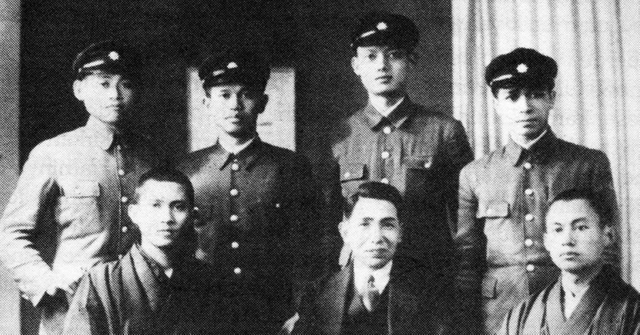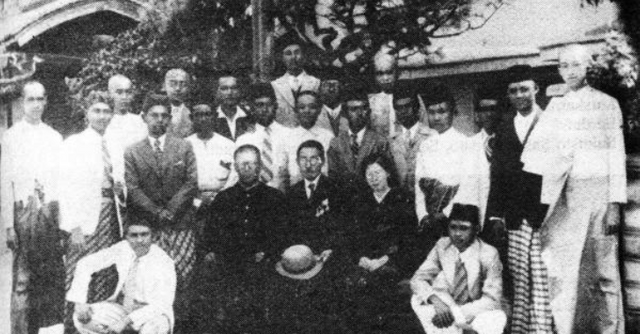The story of Indonesian students surviving the atomic bomb and saving victims

Indonesian students studying in Hiroshima, 1943-1944. Left-right (standing): Sukristo Sastrowarsito, Sam Suhaedi, Supadi, and Tarmidi. (Sitting): Muskarna Sastranegara, Japanese, Sudio Gandarum. (Repro like Indonesian Students in Japan). Source
The Bunridai Tokubetsu Gakka campus in Horishima, Japan, seemed deserted on the morning of August 6, 1945. Many classes were empty without students and young lecturers. They have joined regularly to the Japanese army as a relief force to deal with attacks by US troops in Japan's main cities since early 1945.
A river runs near the campus. The sound of river flow is usually easily heard by students. But not that morning. United States bombers fly over campus. Japanese security guards sound alarm signals. His voice roared, swallowing the sound of the river.
Four students, two from Indonesia (Arifin Bey and Hasan Rahaya) and two from Malaya, were in class when the sound of bombers and sirens rang. They are still new as well as foreigners so they must continue to study on campus. Their lecturers are elderly. His body was thin as well as malnourished people. The steps are too bad.
"Teaching staff like this are living on campus," Arifin recalled in Pertiwi No. 4, June 16-29 1986.
The old lecturer just appeared in class after the sound of bombers and sirens disappeared from his hearing. He had hidden in the campus basement when he heard the sound of bombers and sirens, according to the safety instructions from the campus
Arifin and his three friends have repeatedly entered the basement to save themselves. "Apparently nothing happened, we didn't enter the hole again," Arifin wrote. They instead saw bombers flying into space and concluded that Hiroshima could not be bombed. At most Kobe or Osaka, they thought.
That morning, Arifin and his three friends were reluctant to see bombers like the previous days. They chose to stay in class, because the sun's rays were quite hot and the lecturers were also present.
Old lecturers start college. His hands held chalk and wrote several sentences on the board. Suddenly a light like flash light penetrated into the room through the classroom window. There is no sound whatsoever. The old lecturer swiftly ran outside the classroom. But suddenly the roof of the building collapsed, befalling the old lecturer and Arifin and his three friends. They fainted.
Arifin's estimates and three of his friends were wrong. Not the Kobe or Osaka target of the bombing, but Hiroshima. And not half-hearted, according to John in the Hiroshima Hersey: When the bomb was dropped, the bomb contained uranium and tens of thousands of times more power than ordinary bombs. That is the atomic bomb, the most powerful explosive device of the time.
Indonesian students in Hiroshima
Why could Arifin and his three friends reach Hiroshima on August 6, 1945? Their story began in 1944. The Japanese government opened the second wave of the Nampo Tokubetsu Ryugakusei program registration. This program provides opportunities for young people in Japanese occupied areas in Southeast Asia to study in Japan.
The first wave of registration took place in early 1943. "A total of 75 youth from all over Java gathered in Jakarta to be screened to 20, the number to be sent to Japan. It turned out that 23 people were boarded, "said Sukristo Sastrowarsito to Sam Suhaedi in the Delights of Indonesian Students in Japan Around the Pacific War 1942-1945.

Southeast Asian student in Hiroshima, 1944. Syarif Adil Sagala squats on the left. (Repro like Indonesian Students in Japan). Source
Sukristo and Sam were among the first groups to leave for Japan in June 1943. Universities in Tokyo became their first place of forging. Here they get preparatory education, such as Japanese language and culture.
After a preparatory education period, the program committee divided the first group into small groups. They are scattered to universities in Japan such as Kyushu and Hiroshima, 900 kilometers from Tokyo.
Sukristo and Sam along with four other people entered the Hiroshima group. When they arrived in the spring of 1944, Hiroshima was far from the frenzied war. "Although it has a very important role in helping the war effort as a concentration of soldiers who will be dispatched to many parts of the battlefield as well as the occupied territories," continued Sukristo.
Sukristo and Sam look at Hiroshima increasingly quiet every day. Young men and Japanese students move to palagan. One day their loneliness was slightly relieved by the presence of the second group of Tokubetsu Ryugakusei Nampo program. Among others, Arifin and his three friends.
That's how Arifin's road can reach Hiroshima on the anniversary of August 6, 1945.
Helping Bomb Victims
Arifin opened his eyes. He slowly regained consciousness. His view is still slurry. All around like night. Dark, black and thick.
A few minutes later, Arifin could see clearly. There was a black mist, ruins of buildings, and dust around it. He saw three of his friends still living. His strength restores. "While revealing the ruins, we went out one by one through the window," Arifin said. They did not know the fate of the old lecturer.
Thin black fog. Arifin and three of his friends ran away from the campus and watched as many buildings had collapsed. A horse is lying dead. The merchant cart was half burned. Molt trees. Latitude people go to various departments. "Some are covered in blood, some have tattered clothes, some even have clothes that have been burned," Arifin explained.
Hiroshima was devastated that morning. But humanity remains upright in Arifin and his three friends. There are still thoughts to save the fate of others.
Arifin and three friends arrived at their dormitory. "Our dorm turned out to be a mess," Arifin said. They shouted and tried to find Syarif Adil Sagala, his friend from Riau. Hearing his name called his friends, Sagala replied. "Here, I am crushed unable to move," Sagala said.
Arifin and his three friends raised the wreckage and managed to remove Sagala. He was only a minor wound to the body, but a severe wound was straining into his eyes.
Arifin and his three friends moved Sagala's body to the edge of the river near the dormitory. They returned to the dormitory to look for the boarding mother and her family.
Arifin and three of his friends heard a woman's voice asking for help from the dormitory debris. They think the mother's dormitory sounds. They immediately approached the origin of the sound, dug up the debris, and learned that it turned out that the voice was from a neighboring woman's dormitory. They raised and lay down on the edge of the river.
The river bank continues to be full of human bodies: men and women of various ages. They are still alive, all over their bodies full of burns or bruises hit by buildings. Some wince in pain and cry. Without the help of Arifin and his three partners, their fate might be different. "I don't remember how many people we carried, maybe ten, maybe more," Arifin said.
Throughout August 6, 1945, only three Indonesian students were on Hiroshima: Arifin, Sagala, and Hasan Rahaya. Whereas Sam Suhaedi, Sukristo, and other Indonesian students who had studied in Hiroshima, were transferred outside Hiroshima before August by the program committee.
There is an Indonesian student named Muskarna Sastranegara. He is still studying in Hiroshima such as Arifin, Sagala, and Hasan Rahaya. But on the day the atomic bomb fell, he was outside Hiroshima for treatment.
Arifin, Sagala, and Hasan Rahaya were able to cross the atomic bomb attack which killed 200 thousand residents of Hiroshima. Arifin and Sagala were exposed to radiation, while Hasan was free. But Arifin and Sagala can continue to enjoy the nature of independence for several decades later. Even building families and children.
Arifin revealed two ways to recover from radiation. The first way to eat nutritious food. The second way to drink sake. "Patients suffering from radiation in Hiroshima heal faster, if he gets used to drinking sake every day," said Arifin.
Arifin died at the age of 85 on September 2, 2010 and Hasan at the age of 90 on November 30, 2014. While Sagala, Historia was still looking for the latest news. Wherever they are now, they have left a legacy of the story of humanity.
This article is quoted at historia.id in the Indonesian version